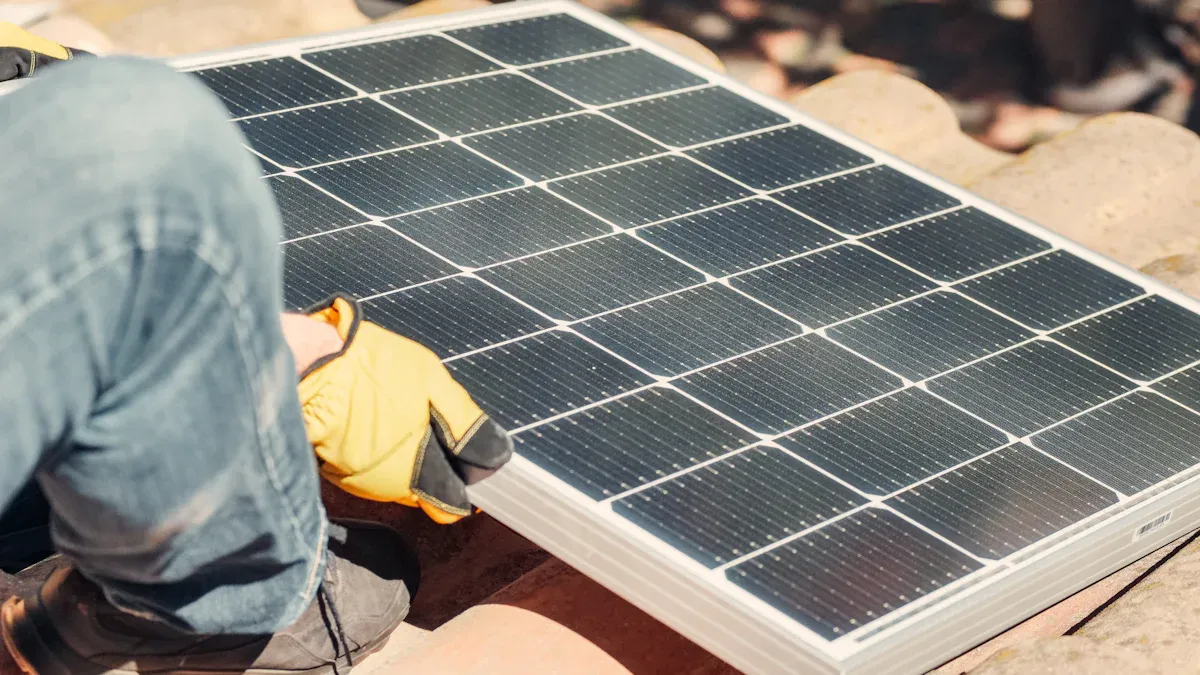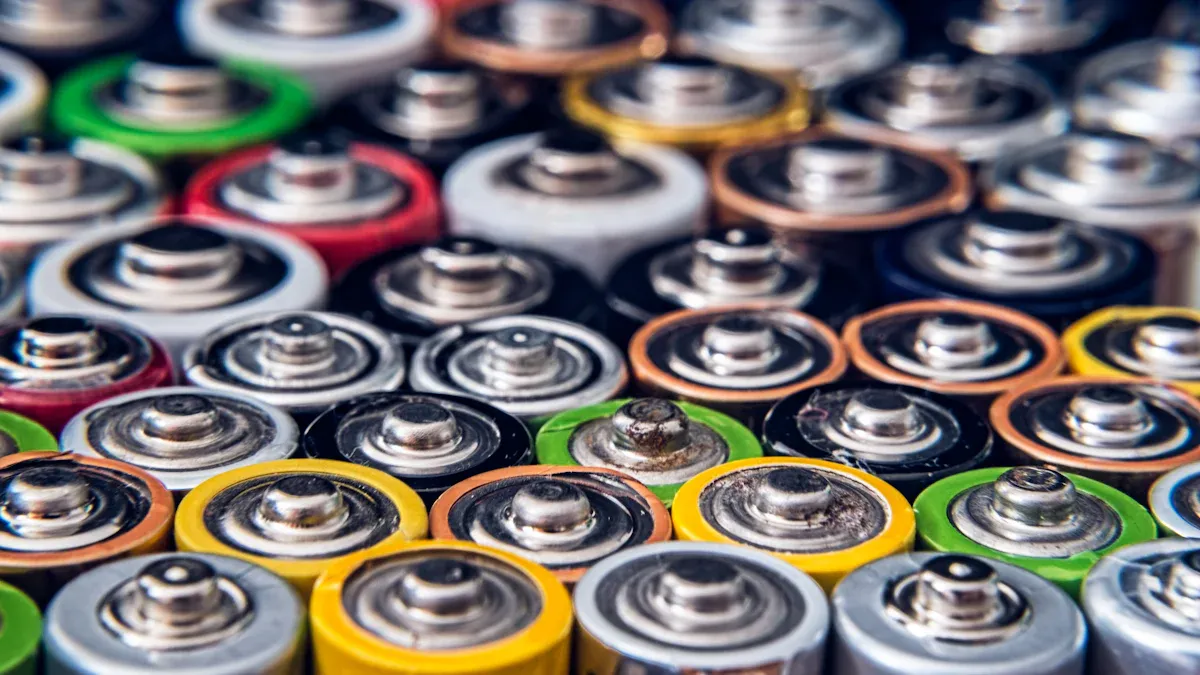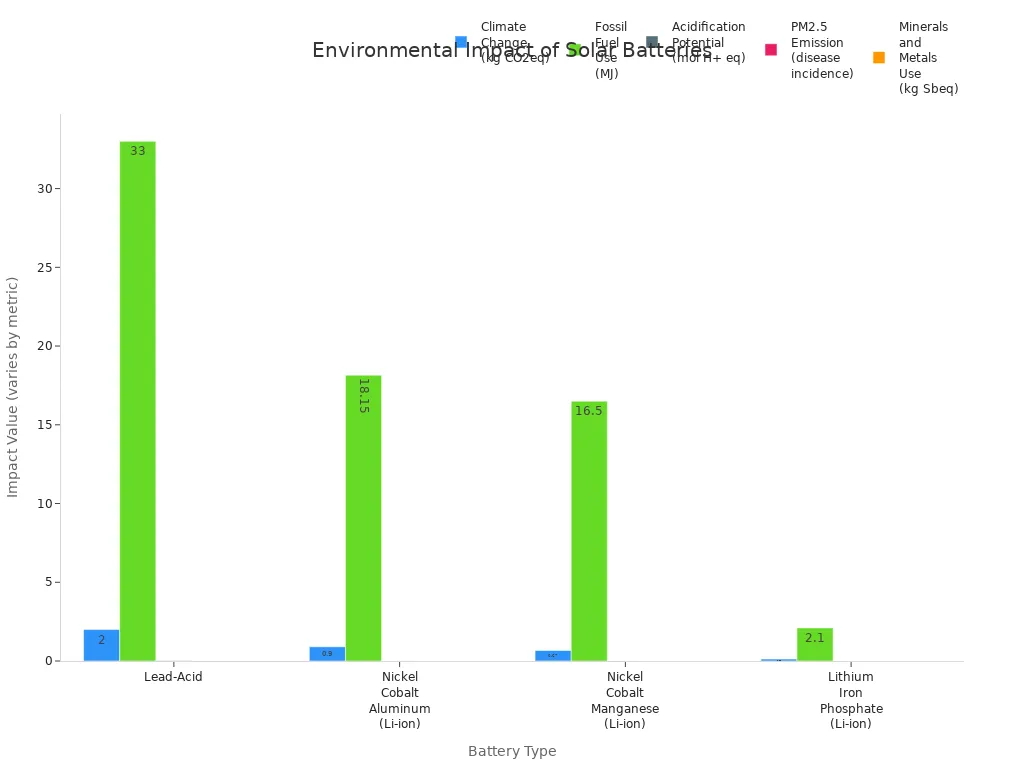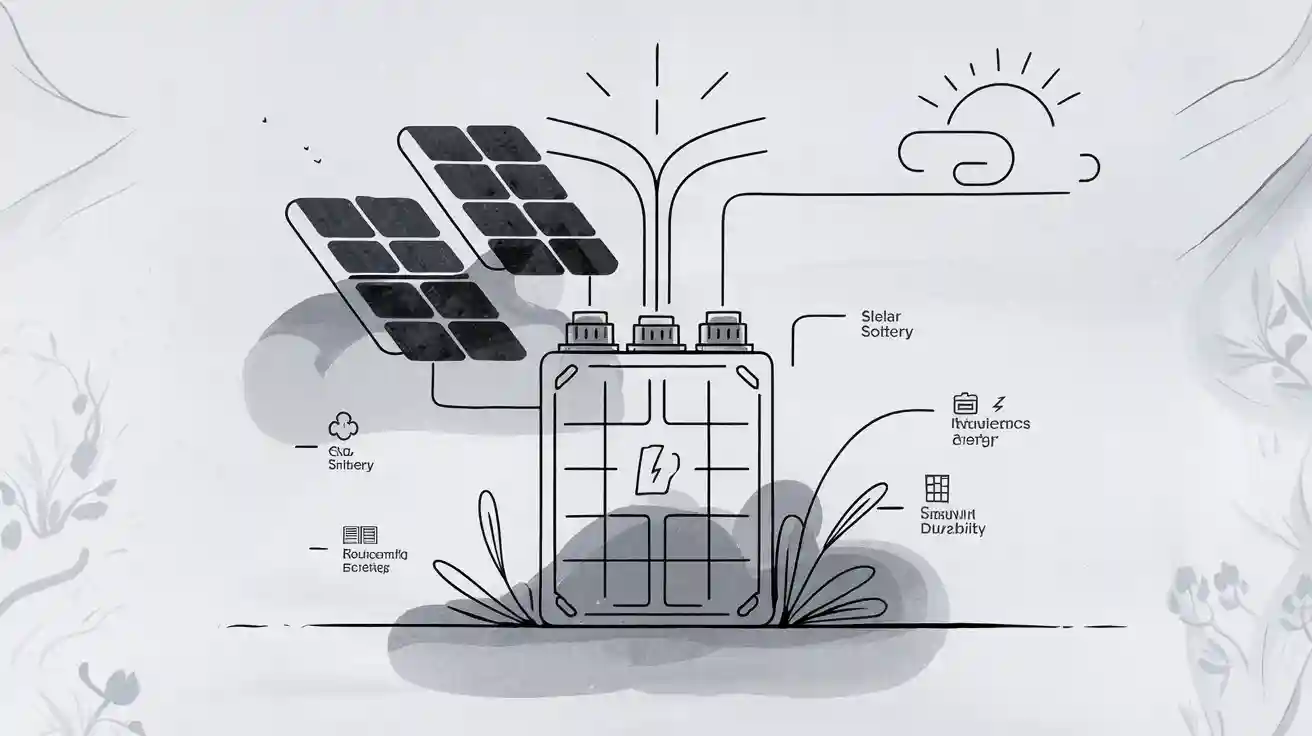What Makes Up the Basic Characteristics of a Solar Battery
You can find out what a solar battery is like by checking its structure, how well it works, how much energy it stores, how long it lasts, how much care it needs, and how it affects the environment. These basic characteristics help you know if the battery is suitable for your house or business.
| Application Type | Preferred Battery Types | Key Characteristics |
|---|---|---|
| Residential | Lead-acid, Lithium-ion | Works well, saves space, easy to look after, reliable |
| Commercial/Industrial | Nickel Cadmium, Flow | Lasts long, handles lots of energy, works in tough weather |
Key Takeaways
- Learn how solar batteries are built. The way they are made changes how well they work and how you put them in. Pick a battery that fits your space and what you need.
- Think about how much energy the battery can store. Pick a battery that matches how much energy you use. Make sure the battery size is right for your building so it works best.
- Pick the best battery type for what you want to do. Lithium-ion batteries are good if you use them a lot. Lead-acid batteries work well if you only need backup power.
Basic Characteristics of Solar Batteries

Solar Battery Structure
The way a solar battery is built is very important. It affects how the battery works and how you put it in place. Most solar batteries have cells made from special materials. These cells can store energy and give it back when needed. The battery has a strong case, cells inside, and connectors to join it to your solar system. The cells keep energy from your solar panels and let it out when you need power.
When picking a solar battery, think about its size and weight. You also need to know where you will put it. Some batteries are heavy and need strong support. Others are lighter and can go on a wall. Make sure there is enough space for air to move around. You also need space to check and fix the battery. The table below shows what matters for putting in and using a battery:
| Factor | Description |
|---|---|
| Ventilation | Good airflow keeps the battery cool and stops it from getting too hot. |
| Ambient Temperature | Stay away from very hot or cold places. This keeps the battery working well. |
| Sunlight Exposure | Keep batteries in the shade or inside to stop them getting too hot. |
| Distance to Inverter | Short cables help the battery work better. |
| Fire Safety Compliance | Follow local rules about where to put the battery. |
| Moisture and Flooding Risks | This is important for basements or outside on the ground. |
| Ease of Maintenance | Make sure you can reach the battery to check or fix it. |
| Structural Suitability | Check that the wall or floor can hold the battery’s weight. |
Different solar batteries need different ways to be put in. Flooded lead-acid batteries must stand up straight and have good airflow. Sealed lead-acid and lithium-ion batteries are easier to put in and need less care. Most good lithium-ion solar batteries can go inside or outside, like in a garage or utility room.
Polarity and P-N Junction
The P-N junction is a very important part of solar battery cells. You will find this in almost every solar cell. It is where two different materials meet. One has more electrons (n-type) and one has fewer (p-type). This meeting point makes an electric field.
- The P-N junction helps the cell turn sunlight into electricity.
- It keeps electrons and holes apart, so the cell can make voltage.
- Electrons move to the p-side and holes move to the n-side. This makes a current.
- The P-N junction is the main way to make voltage in solar cells.
- This idea is used in other ways to store energy too.
Polarity is also very important. You must connect the positive and negative ends the right way. This keeps your solar system safe and working well. If you connect them wrong, you can break the battery or the system.
Energy Storage Capability
Energy storage capability is one of the most important things about solar batteries. It tells you how much energy the battery can keep and give when you need it. Storage is measured in kilowatt-hours (kWh). The right size depends on how much energy you use and your building type.
- Small buildings with low needs use 10-20 kWh systems.
- Medium buildings, like warehouses, use 50-100 kWh systems.
- Big buildings, like shopping centres, may need 100-200 kWh or more.
Solar batteries keep energy as direct current (DC). Your home uses alternating current (AC), so the system must change DC to AC. There are two main types of systems:
| System Type | Energy Flow Description | Inversion Count | Efficiency Loss |
|---|---|---|---|
| AC-Coupled | DC from solar panels is changed to AC, stored, then changed back to AC for use. | 3 | Higher losses |
| DC-Coupled | DC from solar panels goes straight to the battery, changed to AC only when used. | 1 | Lower losses |
- Solar panels make DC electricity.
- In AC-coupled systems, DC is changed to AC for your home.
- In DC-coupled systems, DC is stored and changed to AC only when needed.
You should also think about round-trip efficiency. DC-coupled systems are usually better because they only change the current once. This means you get more useful energy from your battery.
Tip: Always check storage size, efficiency, and how to put in the battery before you choose one for your system. These things will help you get the best use and value from your solar battery.
Performance Parameters and Lifespan
Open Circuit Voltage & Short Circuit Current
You need to know about volt ampere characteristics to see how solar batteries work. Open circuit voltage is the highest voltage a battery can have when nothing is connected. Short circuit current is the most current the battery gives if the ends touch. These things help you check if your solar battery is safe and works well.
- High-capacity batteries can give thousands of amps in a short circuit. This can melt wires or start fires.
- Solar panels have a set short circuit current, usually about 6A for a 110W panel in full sun.
- Bad cables or poor grounding can cause electric shocks.
- Each battery module might give up to 3.8 kA if there is a fault, so always follow safety rules.
Maximum Output Power & Fill Factor
Maximum output power is an important part of how solar batteries work. It shows the most power your battery can give. The fill factor helps you see how well your battery changes energy. You can work it out with this formula:
Fill Factor (FF) = Maximum Output Power / (Short Circuit Current × Open Circuit Voltage)
A higher fill factor means your solar battery works better and gives more backup.
Conversion Efficiency
Conversion efficiency shows how well your solar battery turns stored energy into power you can use. How well your battery works depends on what it is made from. Old silicon batteries reach 15% to 20% efficiency. Monocrystalline types can go up to 22%. Newer cells, like multi-junction or perovskite, can go over 30%. Higher efficiency means you get more energy for your needs.
Cycle Life & Lifespan
The cycle life and lifespan of your solar battery show how long it gives good backup. Here is a table to help you compare:
| Battery Type | Cycle Life (80% Discharge) | Lifespan (Daily Use) |
|---|---|---|
| Lithium-Ion | 5,000–10,000 cycles | Over 14 years |
| Lead-Acid | 400–500 cycles | Less than 2 years |
You can see lithium-ion batteries last much longer and give better backup.
Temperature Effects & Maintenance
Temperature changes can change how solar batteries work. Hot weather can make them work better for a short time but also wears them out faster. Cold weather can lower how much energy they store and may harm the battery. You should:
- Check your battery often for damage.
- Keep it clean and let air move around it.
- Store it inside when the weather is very hot or cold.
Looking after your battery helps it last longer. Lithium-ion batteries need less care than lead-acid ones. You do not need to add water, so they are easier to use. Solar batteries also help the environment by using clean energy and cutting down on fossil fuels.
Types of Solar Batteries

Lithium and Lead-Acid Batteries
There are two main types of solar batteries. These are lithium ion batteries and lead-acid batteries. Each type has special features that change how you use them.
- Lithium ion batteries can hold more energy in less space. They have a higher energy density than lead-acid batteries.
- Lithium ion batteries are lighter and easier to carry. They store three to four times more energy for the same weight.
- Lead-acid batteries are much heavier and bigger. You need more room and stronger support to install them.
- Lithium ion batteries are easy to move. You can use them where weight and space are important, like in electric cars or portable solar kits.
These two battery types also affect the environment in different ways. The table below shows how lithium ion batteries and lead-acid batteries compare in several areas:
| Battery Type | Climate Change (kg CO2eq) | Fossil Fuel Use (MJ) | Acidification Potential (mol H+ eq) | PM2.5 Emission (disease incidence) | Minerals and Metals Use (kg Sbeq) |
|---|---|---|---|---|---|
| Lead-Acid | 2 | 33 | 0.02 | 10−7 | 8 × 10−4 |
| Nickel Cobalt Aluminum (Li-ion) | 0.9 | 18.15 | 0.006 | 5 × 10−8 | 1.6 × 10−4 |
| Nickel Cobalt Manganese (Li-ion) | 0.67 | 16.5 | 0.0067 | 5 × 10−8 | 1.2 × 10−4 |
| Lithium Iron Phosphate (Li-ion) | 0.12 | 2.1 | 0.0006 | 1 × 10−8 | 0.0005 |

You can see lithium ion batteries are better for the environment. They cause less climate change and use fewer resources. Lead-acid batteries make more pollution and use more minerals.
Suitability for Applications
You must pick the right solar battery for your needs. Lithium ion batteries are best if you charge and use them often. You can use them at home, at work, or off-grid. They last longer, need less care, and charge fast.
Lead-acid batteries are good for backup power. They work well where you do not use the battery a lot. Flooded lead-acid batteries cost less but need checks and water added. Valve-regulated lead-acid batteries, like AGM and GEL, are sealed and easier to look after, but they cost more.
Lithium iron phosphate batteries are great for faraway places. You do not need to look after them, and they last the longest. You can use them for off-grid solar, cabins, and remote stations.
Tip: If you want to save money at first, lead-acid batteries cost less. If you want better performance and longer life, lithium ion batteries are a better deal over time.
You should also think about the total cost of your solar battery system. If you add batteries to a solar setup you already have, it may cost more. Redox flow batteries can save money in some places. Lithium ion batteries may not save as much in places with cheap energy.
When picking a solar battery, you should think about how it is built, how well it works, how long it lasts, and how it affects the environment. These things help you choose the right battery for what you need.
| Characteristic | Why It Matters |
|---|---|
| Efficiency | Helps you use less energy and spend less money |
| Capacity | Makes sure you have enough power each day |
| Lifespan | Means the battery will last a long time |
FAQ
What is the best solar battery for residential use?
Lithium-ion batteries are best for most homes. They last a long time and work well. These batteries are stable and give good power for your solar system.
How often do residential solar batteries need maintenance?
Lithium-ion batteries in homes need little care. Lead-acid batteries must be checked often. Always do what the maker says to keep your battery working well.
Can I add a solar battery to my existing home solar power system?
You can add a battery to most home solar systems. This makes your system more stable. You can save extra energy for night or power cuts.
-

 May.2025.11.24Ternary Lithium Battery vs Lithium-ion: Complete Comparison Guide (2025 Edition)Learn More
May.2025.11.24Ternary Lithium Battery vs Lithium-ion: Complete Comparison Guide (2025 Edition)Learn More -

 May.2025.11.214S2P 18650 14.8V Battery: Complete Technical Guide, Specs, Applications & SafetyLearn More
May.2025.11.214S2P 18650 14.8V Battery: Complete Technical Guide, Specs, Applications & SafetyLearn More -

 May.2025.11.18PCM vs BMS in Lithium Batteries: What’s the Difference and Which One Do You Need?Learn More
May.2025.11.18PCM vs BMS in Lithium Batteries: What’s the Difference and Which One Do You Need?Learn More -

 May.2025.11.17Custom Li-ion Battery Design for Medical Devices (2025 Comprehensive Guide)Learn More
May.2025.11.17Custom Li-ion Battery Design for Medical Devices (2025 Comprehensive Guide)Learn More -

 May.2025.11.17The Future of Lithium-Ion Batteries: Innovation, Sustainability, and Global Market TrendsLearn More
May.2025.11.17The Future of Lithium-Ion Batteries: Innovation, Sustainability, and Global Market TrendsLearn More
















